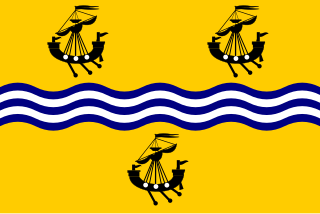
The Outer Hebrides or Western Isles, sometimes known as the Long Isle or Long Island, is an island chain off the west coast of mainland Scotland. The islands are geographically coextensive with Comhairle nan Eilean Siar, one of the 32 unitary council areas of Scotland. They form part of the archipelago of the Hebrides, separated from the Scottish mainland and from the Inner Hebrides by the waters of the Minch, the Little Minch, and the Sea of the Hebrides.

The Inner Hebrides is an archipelago off the west coast of mainland Scotland, to the south east of the Outer Hebrides. Together these two island chains form the Hebrides, which experience a mild oceanic climate. The Inner Hebrides comprise 35 inhabited islands as well as 44 uninhabited islands with an area greater than 30 hectares. Skye, Mull, and Islay are the three largest, and also have the highest populations. The main commercial activities are tourism, crofting, fishing and whisky distilling. In modern times the Inner Hebrides have formed part of two separate local government jurisdictions, one to the north and the other to the south. Together, the islands have an area of about 4,130 km2 (1,594 sq mi), and had a population of 18,948 in 2011. The population density is therefore about 4.6 inhabitants per square kilometre.
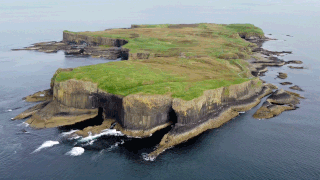
Staffa is an island of the Inner Hebrides in Argyll and Bute, Scotland. The Vikings gave it this name as its columnar basalt reminded them of their houses, which were built from vertically placed tree-logs.

Tobermory is the capital of, and until 1973 the only burgh on, the Isle of Mull in the Scottish Inner Hebrides. It is located on the east coast of Mishnish, the most northerly part of the island, near the northern entrance of the Sound of Mull. The village was founded as a fishing port in 1788; its layout was based on the designs of Dumfriesshire engineer Thomas Telford. It has a current population of about 1,000. It is notable for appearing in the 2002–05 children's programme Balamory by the BBC.

The Isle of Mull or just Mull is the second-largest island of the Inner Hebrides and lies off the west coast of Scotland in the council area of Argyll and Bute.

Belnahua is one of the Slate Islands, in the Firth of Lorn in Scotland, known for its deserted slate quarries. The bedrock that underpins its human history is part of the Scarba Conglomerate Formation and its value has been on record since the 16th century. Likely uninhabited before commercial quarrying commenced, under the control of the Stevenson family during the 19th century the population expanded to over 150 before the island was abandoned again in 1914.
The Treshnish Isles are an archipelago of small islands and skerries, lying west of the Isle of Mull, in Scotland. They are part of the Inner Hebrides. Trips to the Treshnish Isles operate from Ulva Ferry, Tobermory, Ardnamurchan and Tiree.

Eilean Chathastail is one of the Small Isles in the Inner Hebrides of Scotland.
Gunna is an island in the Inner Hebrides of Scotland.
Hermetray is an uninhabited island off North Uist, in the Outer Hebrides of Scotland.
Stromay is a tidal island off North Uist in the Sound of Harris, Scotland.

Eilean Ighe is a small tidal island near Arisaig in the Inner Hebrides of Scotland.

Eilean Trodday is an island in The Minch just off the north coast of the Trotternish peninsula of Skye in Scotland.
The Torran Rocks are a group of small islands and skerries located between the islands of Mull and Colonsay in Scotland.
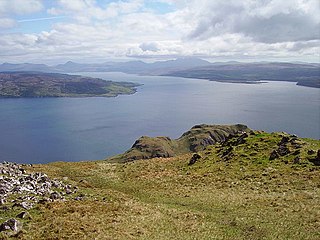
The Sound of Mull is a sound between the Inner Hebridean island of Mull and mainland Scotland. It forms part of the Atlantic Ocean.
The San Juan de Sicilia was one of the 130 ships that formed the ill-fated Spanish Armada of 1588. The ship was originally known as the Brod Martolosi, before it was seized to form part of the navy. It was one of 10 ships forming the Levant squadron, one of 8 squadrons that formed the entire armada.
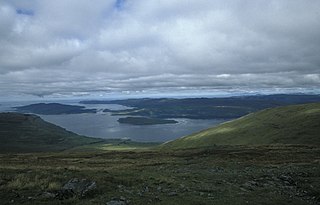
Loch na Keal, meaning Loch of the Kyle, or Narrows, also Loch of the Cliffs, is the principal sea loch on the western, or Atlantic coastline of the island of Mull, in the Inner Hebrides, Argyll and Bute, Scotland. Loch na Keal extends over 20 kilometres (12 mi) inland, almost bisecting Mull, and extending to within 5 km (3 mi) of the eastern shore. The loch gives its name to the Loch na Keal National Scenic Area, one of forty national scenic areas in Scotland.
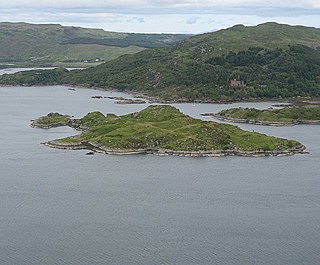
Risga is an uninhabited island in between Càrna and Oronsay, in the centre of Loch Sunart, about 800 yards (730 m) from the north shore, in the council area of Highland, Scotland. Its area is 12 hectares and its highest elevation is 43 metres (141 ft). In 1950, over 50 pairs of Lesser black-backed gull were recorded. The island is included in the grounds of Glenborrodale Castle and is part of Sunart SSSI. Ross Rock is located about 200 yards (180 m) from Risga. Risga has at least 60 crotagans along the east coast, used for fishing. Risga is a rocky island.
















